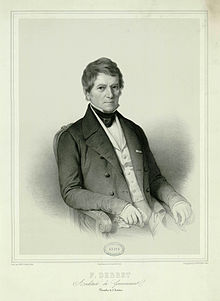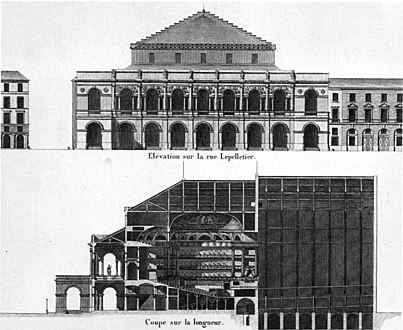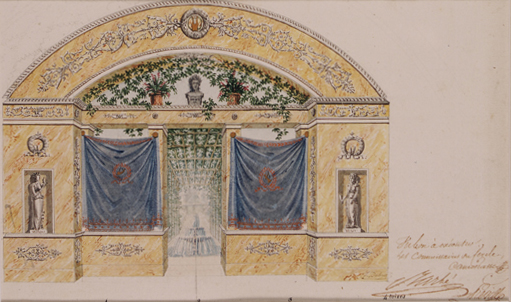François Debret
François Debret | |
|---|---|
 | |
| Born | 27 June 1777[1] Paris |
| Died | 19 February 1850 (aged 72) |
| Resting place | Père Lachaise Cemetery 48°51′43″N 2°23′39″E / 48.861944°N 2.394167°E |
| Nationality | French |
| Occupation | Architect |
François Debret (27 June 1777 – 19 February 1850) was a 19th-century French architect and
Early life and training
Born in Paris, François Debret was the son of Jacques Debret, criminal court clerk of the Parliament of Paris. He was the younger brother of Jean-Baptiste Debret. In 1808, he married a sister of the architect Félix Duban. Their son, Francis, born in 1809, graduated from the French Académie des Beaux-Arts (Academy of Fine Arts).
Around 1793 Debret studied with Charles Percier.[2]
Career
In 1813, Debret succeeded
In 1818–1819, he was assigned the task of transforming the former Augustinian convent in Paris into the
Debret was more successful with his theatre designs. After restoring Nicolas Lenoir's
Debret was elected a member of the Académie des Beaux-Arts in 1825 and became inspector general to the Conseil Général des Bâtiments Civils (General Council of Civil Buildings) in 1841. He was replaced by Rohault de Fleury as the architect of the Opéra in 1846 and shortly after the February Revolution of 1848 was dismissed as inspector general.[2]
Among his students and apprentices was Antoine-Nicolas Bailly.
Achievements
- Restoration of several theaters and buildings of the École des Beaux-Arts (1822–1832), set in the old musée des monuments français, founded in 1795 in the former Couvent des Petits Augustins, and closed by Louis XVIII in 1816. This work was continued by his brother-in-law Félix Duban.
Gallery of works
-
Pavillon de Hanovre on the Boulevard des Italiens.
-
Salle Le Peletier, the Paris Opera from 1821 to 1873.
-
Transformable room for show, concert and dance, 1779.
-
Transformable room for show, concert and dance, 1799.
Notes
Bibliography
- Curl, James Stevens (2006). Oxford Dictionary of Architecture and Landscape Architecture, 2nd edition. Oxford and New York: Oxford University Press. ISBN 9780198606789.
- Lance, Adolphe (1872). Dictionnaire des Architectes français, 2 volumes. Paris: A. Morel. Vol. 1 and 2 at Google Books.
- Mead, Christopher (1996). "Debret, François", vol. 8, pp. 592–593, in ISBN 9781884446009. Also at Oxford Art Online, subscription required.
- Wild, Nicole ([1989]). Dictionnaire des théâtres parisiens au XIXe siècle: les théâtres et la musique. Paris: Aux Amateurs de livres. .




